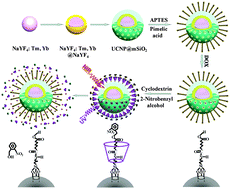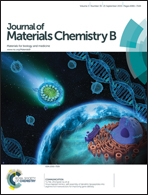NIR light responsive core–shell nanocontainers for drug delivery†
Abstract
A novel near infrared (NIR)-triggered anticancer drug delivery system has been successfully constructed. Firstly, upconversion nanoparticles (UCNPs, NaYF4:Tm,Yb@NaYF4) were synthesized as a core and mesoporous silica (mSiO2) as a shell to assemble the core–shell nanostructure (UCNP@mSiO2) as the host. Supramolecular nanovalves based on α-cyclodextrin (α-CD) torus encircling a pimelic acid thread and being held in place by a cleavable stopper (nitrobenzyl alcohol) were used as nanoscopic caps to block the pore and inhibit drug diffusion. Upon irradiation with a 980 nm laser on the nanocomposites, the emitted ultraviolet light (UV, 360 nm) photocleaved the o-nitrobenzyl (ONB) photolabile group, causing these α-CD caps to dissociate from the stalk and release the drug. The “Ladder” pulsatile release-profiles, regulated by varying the intensity and time duration of NIR irradiation, further reveal the light-triggered release performance. In addition, without NIR irradiation, few immaturities ensure the high pharmacological efficacy. Moreover, the elaborate cell experiments, by using HeLa as model cancer cells, were also carried out to reveal the good biocompatibility, fast uptake and NIR light-sensitive toxicity. Therefore, the novel NIR light-triggered drug delivery system displays great potential for cancer therapy.


 Please wait while we load your content...
Please wait while we load your content...